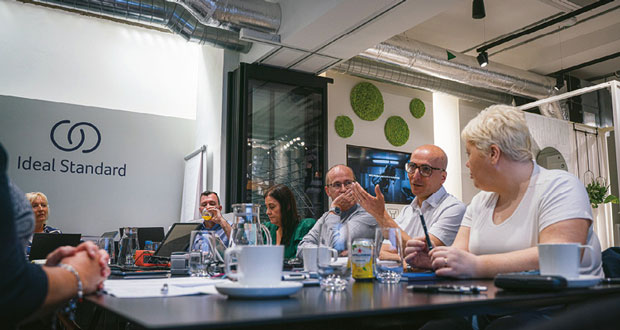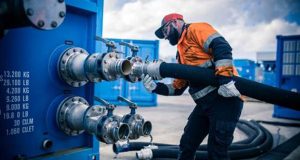Anil Madan, Non-Residential Marketing Manager at Ideal Standard reports on an event to discuss waterborne pathogens and the role of facilities managers and multi-disciplinary teams in healthcare
Following the recent update to British Standard 8580-2: Risk assessments for Pseudomonas aeruginosa and other waterborne pathogens, Armitage Shanks brought together experts from across the healthcare sector at the company’s London Specification and Design Centre in Clerkenwell. Attendees included clinical leads responsible for infection control, water services managers, engineers, contract managers, microbiologists, and scientific writers, alongside innovation and specification representatives from Armitage Shanks.
Healthcare-associated infections (HCAIs), such as those caused by waterborne pathogens, have a significant impact in the UK, causing thousands of days of absenteeism for healthcare professionals, millions of occupied hospital bed days, and billions in costs for the NHS. Adding to this, HCAI’s can cause considerable harm and distress to patients, many of whom are already seriously ill.
When looking at areas where facilities managers can be extra vigilant, hospital complexes play host to ‘goldilocks zones’ for pathogens where water supply systems provide the perfect temperature and moisture conditions for them to prosper. With the far-reaching nature of these systems, it’s not just healthcare professionals who now must beware of the dangers, but anyone who has contact with the water supply system, including manufacturers, engineers, construction managers and, crucially those in charge of ongoing maintenance.
IMPLEMENTING THE GOLD STANDARD
Earlier in 2022, the British Standard 8580-2 was issued to engage with these issues and assess how teams may collaboratively approach and prevent waterborne infections. The Standard revisits the risk assessment process, and provides a step-by-step guide that is accessible for those conducting them, regardless of team and for the facilities mangers who are in charge.
A key part of the revised Standard, the need to engage a diverse cross-section of roles is clear to see. In part this is through the Standard’s focus on the risk assessment processes and its aims to create absolute clarity in its results. Red/amber/green rating systems are encouraged to ensure clarity, as numerical scales can be independently interpreted while a risk rating of ‘red’ leaves no room for doubt.
The added clarity and step-by-step process reaffirm the bottom line of the Standard, which aims to raise awareness of HCAIs caused by waterborne infection and broaden responsibility throughout teams and facilities managers.
The gold standard suggested is a multi-disciplinary approach that can foresee risks, while working to guard against infection at every stage – from hospital CEO to clinical teams and, significantly, FMs.
EXPANDING THE SCOPE OF RESPONSIBILITY
In practice, the scope of people who have contact with water systems in healthcare settings, the terms on which they work, and the diversity of training and experience are all substantial barriers to ensuring this multi-disciplinary approach can be adopted. It’s therefore key for teams to come together under one direction with FMs helping to assess the wider role and engage all of those involved.
FMs need to be key drivers in raising awareness around the waterborne pathogens as well as in delivering the education and training necessary to combat and prevent the issues and dangers they present. It became clear at the forum that responsibility for delivery, alongside the variety of jobs and internal structures in place across facilities are causing blockers in putting effective measures in place.
With the expansion of responsibility beyond, new priorities and challenges quickly become clear – here FMs must play a critical role in balancing the needs of the multi-disciplinary team and engaging teams, from clinicians to maintenance staff. With some parts of the team having more familiarity with the risks and prevention methods than others, robust and ongoing training will be key to successfully mitigating water safety risks.
By linking the practical steps team members can take to reduce risks with the tangible benefits their actions bring, it can also help ensure and clarify the need for implementing these measures and the necessity to protect all parties. In particular, with the added threat to patients and carry-on effects for healthcare professionals, FMs for hospitals and healthcare settings need to ensure the full team is equipped with the knowledge and understanding to prevent the spread of waterborne pathogens.
Universal competency was raised as the end goal of training strategies, with comprehensive, engaging and detailed training as the route leading to this.
LOOKING TO THE FUTURE
The consensus of the forum was that FMs will have a key role to play in progressing implementation of the Standard, each individual will have to take responsibility – from installation and maintenance to usage throughout the multidisciplinary team. However, this responsibility does not solely lie with FMs and the way forward is undoubtedly a holistic approach founded on a basis of knowledge, competency and collaboration.
For those who attended the discussion, it was an opportunity to share insights from their own areas of expertise and understand the issues from different perspectives. For Armitage Shanks, it was a chance to better define and update its understanding of the role it plays in serving the needs of its users, reiterating its commitment to supporting FMs and the environments they operate in.
For more information, visit: https://bit.ly/3rfpIni





